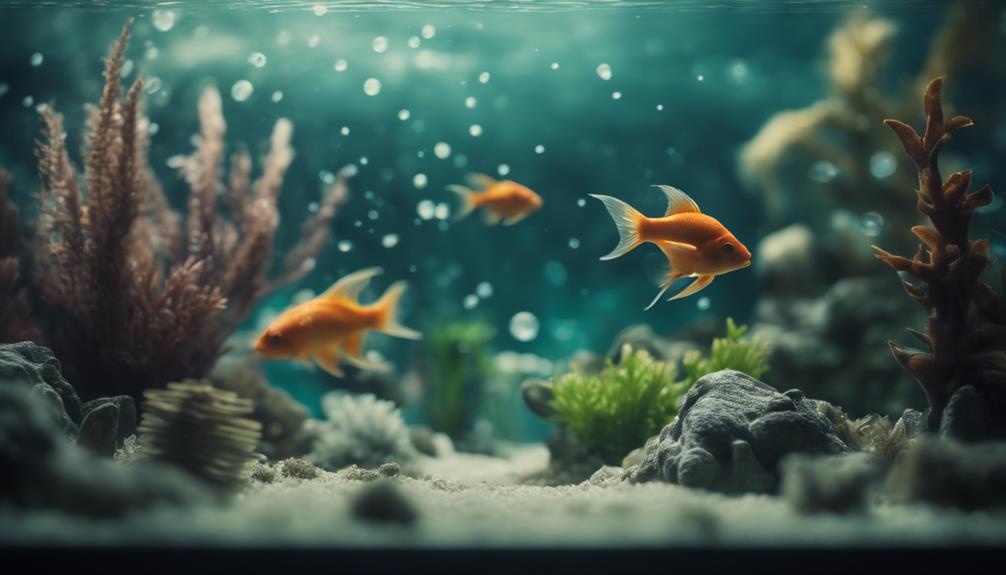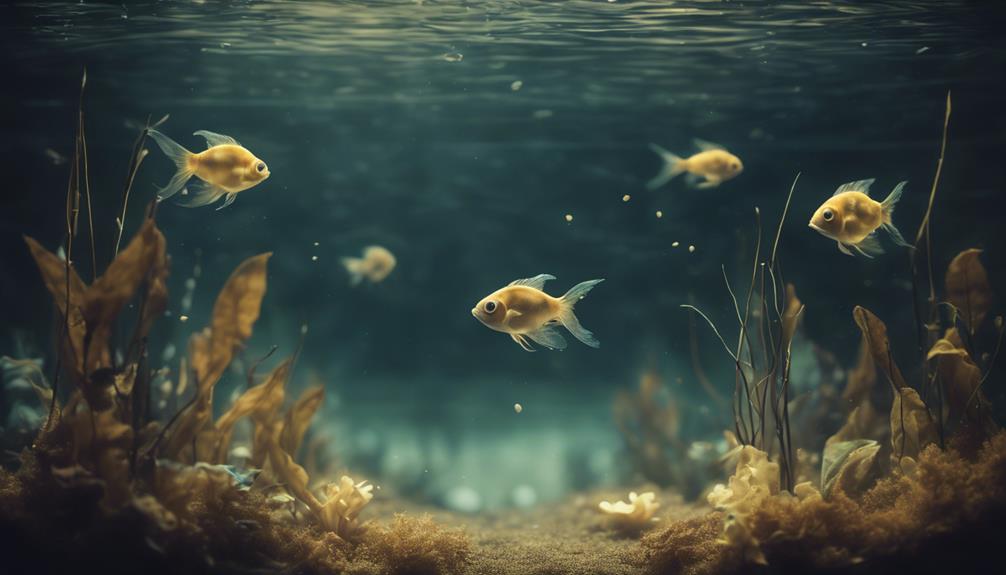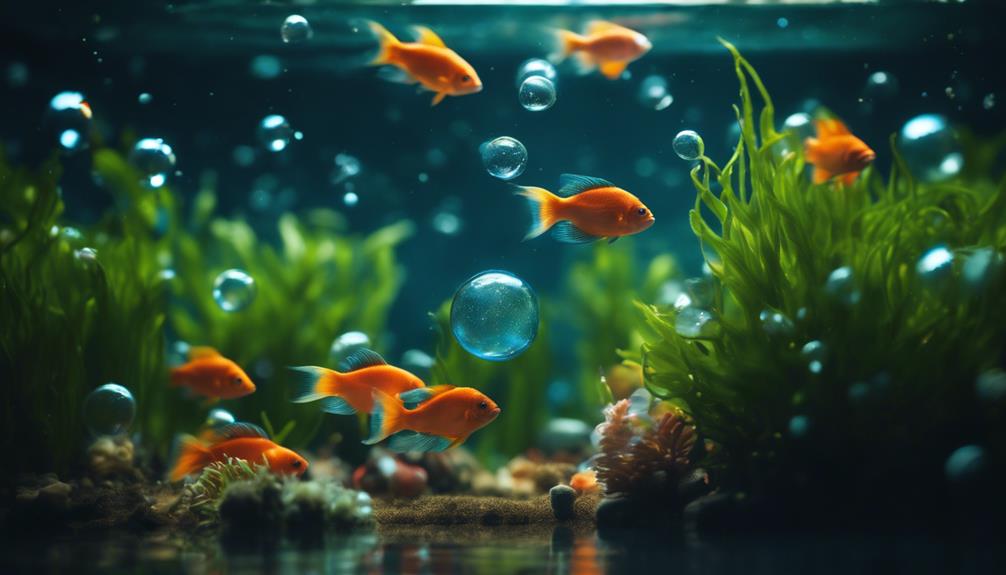You can markedly boost oxygen levels in your aquarium by combining aeration methods, such as powerheads or air stones, with a well-designed water circulation system and live plants that produce oxygen through photosynthesis. Regular water changes and a balanced ecosystem also play vital roles in maintaining healthy oxygen levels. Additionally, understanding oxygen requirements, monitoring levels, and recognizing deficiency symptoms are essential for creating a premier environment. By implementing these strategies, you'll be well on your way to creating a thriving aquarium – and as you explore further, you'll discover even more ways to fine-tune oxygen levels for your fish and plants.
Table of Contents
Key Takeaways
- Live plants produce oxygen through photosynthesis, guaranteeing proper water circulation and ideal oxygen levels.
- Regular water changes and a balanced ecosystem ensure healthy oxygen levels for fish and plants.
- Aeration methods, such as powerheads or airstones, increase water movement and circulation, boosting oxygen levels.
- Properly designed water circulation systems guarantee even oxygen distribution throughout the tank.
- Introducing oxygen-producing plants like anacharis or hornwort supplements oxygen levels, supporting healthy fish and plants.
Oxygen Essentials for Aquatic Life
As you plunge into the world of aquatic life, it's essential to recognize that oxygen is the lifeblood of your fish and plants, and its presence is what sets the stage for a thriving ecosystem.
You need to understand that oxygen is necessary for the survival of your aquatic friends, and low levels can lead to their downfall.
The good news is that you can guarantee ideal oxygen levels by maintaining a balanced ecosystem.
For instance, you should aim to keep dissolved oxygen levels between 6-8 mg/L and oxygen saturation between 80-110%.
This will provide your fish with the oxygen they need to prosper.
You can achieve this by incorporating live plants, which produce oxygen through photosynthesis, and guaranteeing proper water circulation.
Regular water changes are also pivotal in maintaining oxygenated water.
By following these guidelines, you'll create a healthy environment where your aquatic life can flourish.
Boosting Oxygen With Aeration Methods
One effective way to boost oxygen levels in your aquarium is by incorporating aeration methods that increase water movement and circulation.
By adding powerheads or airstones, you can create a gentle flow that helps dissolve oxygen into the water. This, in turn, increases the oxygen levels available to your fish and plants.
In emergency situations, portable aeration methods like portable splash or spray type aerators can rapidly increase dissolved oxygen levels.
For larger bodies of water, fixed aeration systems, including diffuser systems and slow-moving paddle-wheels, provide a constant and evenly distributed source of oxygen.
With the right aeration method, you can increase oxygen levels by up to 30% in your aquarium, depending on the type and size of the tank.
Proper aeration is vital for maintaining peak oxygen levels, which is essential for healthy fish and plants.
Importance of Water Circulation Systems

As you set up your aquatic ecosystem, you'll soon realize that water circulation systems are vital for maintaining healthy fish and plants.
You need to guarantee that water is constantly moving to prevent stagnant areas, which can lead to oxygen depletion and algae growth.
Water Movement Essentials
Every aquarium requires a well-designed water circulation system to guarantee that oxygen is distributed evenly throughout the tank, preventing stagnant areas that can harm fish and plants.
As you set up your aquarium, you'll want to confirm that your water movement is adequate. This can be achieved through the strategic placement of air stones, which create gentle water movement and increase oxygen levels. Additionally, a spray bar can be used to create a more dynamic water flow, further enhancing oxygen distribution.
Without proper water movement, oxygen depletion can occur, leading to stress and even death in fish and plants. You'll want to aim for a water movement of at least 10-15 times the tank's volume per hour.
Optimal Aeration Techniques
You can substantially boost oxygen levels and create a thriving environment for your fish and plants by incorporating ideal aeration techniques into your water circulation system.
By increasing O2 levels, you'll promote healthy respiration and metabolism in your aquatic friends. Proper aeration also helps prevent bubble disease, a common issue caused by excessive gas buildup in the water.
To maximize aeration, consider upgrading to a high-performance pump or adding a diffuser to your setup.
These tools will efficiently distribute oxygen-rich water throughout your tank, ensuring all inhabitants receive the necessary O2.
Regular water changes also play a vital role in maintaining peak aeration.
By replacing 10-20% of your tank water weekly, you'll remove stagnant water and introduce fresh, oxygen-rich water.
This routine won't only increase oxygen levels but also reduce waste buildup and prevent water stagnation.
Understanding Oxygen Requirements and Monitoring
As you aim to create a thriving aquarium, it's essential that you understand the oxygen requirements of your fish and plants.
You need to guarantee that your aquarium water maintains perfect oxygen saturation levels, between 80-110%, to prevent stress and disease in your aquatic life.
Oxygen Saturation Levels
Maintaining peak oxygen saturation levels is essential in aquariums, where an ideal range of 80-110% and a Dissolved Oxygen (DO) level of 6-8 mg/L guarantee a healthy environment for fish and plants to thrive.
You should avoid supersaturation, which can lead to gas bubble disease in fish. Regular monitoring of oxygen levels is pivotal to secure prime conditions, as insufficient O2 levels can cause stress and disease in fish.
As you know, fish rely on gaseous exchange to obtain oxygen, which takes place at the water surface, exchanging carbon dioxide (CO2) from the aquarium water and O2 from the surrounding air.
To boost O2 levels, you can increase aeration (water movement) and incorporate live plants that undergo photosynthesis, dissolving oxygen into the water.
Monitoring Oxygen Deficiency
Monitoring oxygen deficiency is critical, since even slight deviations from ideal levels can trigger adverse reactions in fish, such as labored breathing, rapid gill movements, and gasping at the surface.
As an aquarium owner, you need to be aware of the oxygen requirements of your fish and plants to guarantee their peak health.
Regular monitoring: Check oxygen levels regularly to detect any deviations from the ideal range of 80-110% oxygen saturation and 6-8 mg/L DO levels.
Species-specific needs: Recognize that different fish species have varying oxygen requirements, and adjust your monitoring accordingly.
Visual signs: Be on the lookout for signs of oxygen deficiency, such as labored breathing, rapid gill movements, and gasping at the surface.
Accurate measurement: Use a dissolved oxygen probe/sensor to accurately measure oxygen levels and take corrective action if necessary.
When monitoring oxygen deficiency, key points to keep in mind include: Regular monitoring, species-specific needs, visual signs, and accurate measurement.
Recognizing Symptoms of Oxygen Deficiency

Recognizing Symptoms of Oxygen Deficiency
Your aquatic inhabitants and plants often display subtle yet telling signs when oxygen levels in the tank dip below ideal ranges. As O2 levels drop too low, you may notice changes in their behavior and appearance. Vital to recognize these symptoms early on is to prevent oxygen deficiency from depleting oxygen further.
| Symptoms in Fish | Symptoms in Plants |
|---|---|
| Labored breathing, rapid gill movement, or gasping at the surface | Yellowing or browning leaves, slow growth, or blackened tips |
| Lethargy, loss of appetite, or erratic swimming patterns | Droopy stems, wilted leaves, or a general lack of vigor |
| Increased aggression or stress-related behavior | Reduced photosynthesis, leading to decreased oxygen production |
If you've noticed any of these symptoms, vital is to investigate the cause and take corrective action to restore peak oxygen levels. Remember, oxygen deficiency can have devastating consequences for your aquatic ecosystem. Stay vigilant, and take the necessary steps to guarantee a healthy and thriving environment for your fish and plants.
Causes and Solutions to Low Oxygen
When it comes to identifying the causes of low oxygen levels in your aquarium, overcrowding, elevated water temperatures, and low water movement are often the primary culprits. These factors can lead to stress, disease, and even death in your fish and plants.
Overcrowding, elevated water temperatures, and low water movement can lead to stress, disease, and even death in your fish and plants.
Overcrowding: Reduce the number of fish in your tank to prevent competition for oxygen.
Elevated water temperatures: Maintain a stable water temperature between 72°F to 82°F (22°C to 28°C) to reduce oxygen consumption.
Low water movement: Add air stones or powerheads to improve water circulation and increase oxygen levels.
Insufficient oxygen-producing plants: Introduce live plants that produce oxygen, such as anacharis or hornwort, to supplement your tank's oxygen levels.
Long-Term Strategies for Oxygen Maintenance

By implementing a combination of these solutions, you can create a balanced environment that fosters healthy oxygen levels, and now, let's explore the long-term strategies for maintaining ideal oxygenation in your aquarium.
To achieve peak O2 levels, crucially, focus on water quality, water movement, and regular maintenance. Here's a breakdown of the key strategies:
| Strategy | Description | Benefits |
|---|---|---|
| Regular Water Changes | Replace 25-50% of tank water every 1-2 weeks | Maintains superior water quality and O2 levels |
| Increased Water Movement | Use powerheads, airstones, or adjust filter output | Enhances oxygenation and circulation |
| Live Plants and Filter Maintenance | Add plants like Hornwort or Anacharis, and maintain a well-maintained filter | Supports steady water properties, increases O2 levels, and breaks down waste |
Frequently Asked Questions
How Can I Give My Fish More Oxygen?
You can boost oxygen for your fish by adding aeration devices like powerheads or Oxygen stones, which increase water agitation, or installing air pumps to create gentle water circulation and oxygen-rich bubbles.
How to Increase Oxygen in Water Naturally?
Want to know the secret to increasing oxygen in water naturally? You can do so by promoting water circulation, adding aquatic plants, using oxygen stones, and creating surface ripples – all of which work together to boost oxygen levels!
What Adds Oxygen to the Aquarium?
You can increase oxygen levels in your aquarium by adding aquatic plants, creating water agitation, using oxygen stones, or installing aeration systems, which effectively boost oxygen for a thriving aquatic environment.
How to Add Oxygen to a Pond Naturally?
You can increase oxygen levels in your pond naturally by promoting water movement, creating surface ripples, and encouraging algae photosynthesis through pond aeration, which can boost oxygen levels by up to 30% in just 24 hours!
Conclusion
Oxygen is the unsung hero of aquatic life.
Now, you're equipped to boost oxygen levels and create a thriving environment for your fish and plants.
But, don't think you can rest on your laurels – oxygen levels can plummet in an instant.
Stay vigilant, monitor regularly, and be prepared to make adjustments.
The fate of your aquatic world hangs in the balance.
Will you be ready to rescue it from the brink of disaster?

